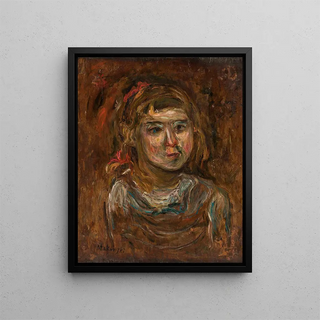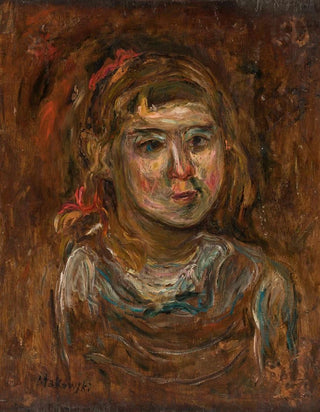Art print | Petite fille avec un ruban rouge - Tadeusz Makowski


View from behind

Frame (optional)
In the vibrant universe of art, some works manage to capture the very essence of childhood through a palette of delicate colors and evocative compositions. The art print Petite fille avec un ruban rouge - Tadeusz Makowski is a perfect example. This painting, depicting a young girl with a dreamy gaze, stands out for its atmosphere that is both gentle and melancholic. The presence of the red ribbon, a symbol of joy and innocence, immediately draws the eye and invites introspective contemplation. Through this piece, Makowski transports us to a world where the simplicity of gestures and emotions takes on full significance, resonating within us with memories of a distant childhood.
Style and uniqueness of the work
Tadeusz Makowski's style is deeply rooted in the expressionist movement, while also incorporating elements of cubism, giving it an unparalleled singularity. In Petite fille avec un ruban rouge, the forms are both stylized and tender. The artist skillfully plays with shadows and lights, creating a striking contrast that highlights the child's face and the ribbon adorning her hair. The colors, carefully chosen, oscillate between warm tones and cooler shades, conveying an emotional duality that engages the viewer. This work does not merely depict a scene from everyday life; it evokes a sense of nostalgia and dreaminess, where each brushstroke seems to whisper forgotten stories.
The artist and his influence
Tadeusz Makowski, born in Poland and active in the early decades of the 20th century, managed to impose his artistic vision at a time when art was undergoing radical transformation. Influenced by European avant-garde currents, he developed a unique visual language, blending the innocence of childhood with deeper reflections on the human condition. His encounters with renowned artists and his stay in Paris enriched his approach, allowing him to incorporate innovative techniques into his work. Makowski is often considered a bridge between Polish pictorial traditions and the

Matte finish

View from behind

Frame (optional)
In the vibrant universe of art, some works manage to capture the very essence of childhood through a palette of delicate colors and evocative compositions. The art print Petite fille avec un ruban rouge - Tadeusz Makowski is a perfect example. This painting, depicting a young girl with a dreamy gaze, stands out for its atmosphere that is both gentle and melancholic. The presence of the red ribbon, a symbol of joy and innocence, immediately draws the eye and invites introspective contemplation. Through this piece, Makowski transports us to a world where the simplicity of gestures and emotions takes on full significance, resonating within us with memories of a distant childhood.
Style and uniqueness of the work
Tadeusz Makowski's style is deeply rooted in the expressionist movement, while also incorporating elements of cubism, giving it an unparalleled singularity. In Petite fille avec un ruban rouge, the forms are both stylized and tender. The artist skillfully plays with shadows and lights, creating a striking contrast that highlights the child's face and the ribbon adorning her hair. The colors, carefully chosen, oscillate between warm tones and cooler shades, conveying an emotional duality that engages the viewer. This work does not merely depict a scene from everyday life; it evokes a sense of nostalgia and dreaminess, where each brushstroke seems to whisper forgotten stories.
The artist and his influence
Tadeusz Makowski, born in Poland and active in the early decades of the 20th century, managed to impose his artistic vision at a time when art was undergoing radical transformation. Influenced by European avant-garde currents, he developed a unique visual language, blending the innocence of childhood with deeper reflections on the human condition. His encounters with renowned artists and his stay in Paris enriched his approach, allowing him to incorporate innovative techniques into his work. Makowski is often considered a bridge between Polish pictorial traditions and the






